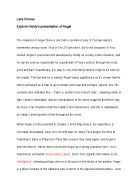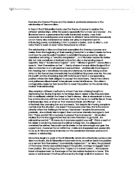Her parents, aware of her beauty, view Tess as an opportunity for future wealth and coupled with the unfortunate circumstance of Prince's death urge Tess to venture from the 'engirdled and secluded region' of Marlott to seek financial assistance from the D’Urbervilles in nearby Trantridge. Marlott is representative of Tess as she too is ‘secluded’ from the dangers of men like Alec in this village. The remote, untouched virgin land has not yet been destroyed by the industrialisation of London and similarly Tess’s innocence and wholesomeness is protected by the ‘engirdled’ village which she is naturally a part of. Here, she first encounters her relative, the sexually dominating and somewhat demonic Alec D'urberville, whom she is later to fall victim to. Alec's first words to Tess is, "Well, my big Beauty, what can I do for you?" and the patronising derogatory manner in which he comments on her ‘big’ beauty shows that he only views her with sexual pleasure. This was the typical view of women of the Victorian Age where people used the idea of purity, an idea of adultery and divorce, and feminine sexuality to trap women. Femininity was idealised in the image of the domestic "angel" which was reflected in religion, art and literature. Prostitutes and unmarried mothers were seen as sexually immoral and condemned as "fallen women". This powerful imagery of "good" and "bad", combined with a sexual double standard, acted as a constraint on women's freedom and sexual behaviour which men did not have. Women, like Tess, are victimised the patriarchal society in which they live according to their purity and their ability to act in accordance to the wishes of their male partners.
Alec then proceeds to charm Tess by pushing strawberries into her mouth and “in a slight distress she parted her lips and took it in.” Tess is obviously overwhelmed by Alec and in awe of his prosperity yet she still has the dignity to feel ‘distress[ed]’ at such sexualised forceful actions. Yet we still see her naivety and pliable nature when she ‘parted her lips’ to consume the ‘strawberries’ which due to its redness symbolises passion and seduction. This is obviously Tess’s fatal flaw as her innocence allows Alec to take advantage of her and the consumption of the strawberries foreshadows how Alec forces himself on Tess and ‘rapes’ her whilst Tess simply gives in. The feeding of the strawberries is thought to be a metaphorical rape as here, too, we see Tess giving into Alec’s temptations. Alec continues to “gather blossoms and gave her to put in her bosom,” which is metaphorically synonymous to the payment he gives her after the rape when he had forced himself on her. The ‘blossoms’ and ‘strawberries’ are symbols of fertility of Tess although they are unwanted her as Alec does not love her or want to procreate – her merely wants to indulge in sexual pleasure, making him ‘evil’ in the eyes of the reader although this was acceptable in the Victorian era as he is of a higher stature. As Mickelson cogently argues, “Tess is part of a class-conscious society which regards the peasant as an inferior member of society and woman as inferior to man.” However I strongly disagree with this statement as Tess doesn’t love Alec and therefore, even though he has the power to take away her virginity, she will not marry him. Hardy portrays Tess as having morals and convictions and even more radically, a mind of her own, which middle class people of that time didn’t think women possessed or deserved. These fruits of love are an indication of Alec's lust and sexual desire for Tess as he preys upon her purity and rural innocence and we see how she is victimised by male desires although she still continues to act accordingly to what she believes.
Tess unwillingly becomes a victim to Alec's inhumane, violent and aggressive sexual advances. Alec, always the master of opportunities, takes advantage of her whilst alone in the woods and rapes her. Tess’s agony is seen through, “But where was Tess’s guardian angel? Where was Providence,” and the rhetorical questions carries an accusatory tone passing the blame of Tess’s corruption onto someone else and still trying to maintain her purity. The use of ‘guardian angel’ shows how even religion is not in favour of Tess and God is not answering her call; although she is so good and pure that she should have been protected from the crueller side of human nature as Alec seizes upon her vulnerability. After this sexual violation and corruption of innocence, Tess flees home and although she has escaped the trap of the sexually rapacious Alec for the time being, her circumstance is similar to that of a wounded animal - her blood of innocence has been released. At this time Hardy gives reference to Shakespeare's 'The Rape of Lucrece' -'where the serpent hisses the sweet birds sing' suggesting that Alec was equivalent to Satan tempting Eve. We see that Tess’s mother fails to tell her the dangers encountered in the outside world, a major part of the reason for Tess’s innocence. As Judith Weismann tells us, “To Hardy’s readers...the word education is likely to have a holy sound, but it is by no means entirely beneficial in Hardy’s novel.” Tess’s having earned this type of education leaves her ill-prepared for dealing with a ruthless man such as Alec D’Urberville. Tess misses out on knowledge about the ways of men, as was common in those times, because of her differing education illustrated in the scene in which Tess returns from home to Marlott after having been raped by Alec D’Urberville. Upon her arrival home, she cries, “Oh Mother, my Mother! How could I be expected to know? Why didn’t you tell me there was danger in men-folk? Tess is undoubtedly a victim of the patriarchal society and her lack of understanding over such matters only increases the guilt that already embodies her.
During her darkest hours, Tess finds no help from the church: the itinerant sign-painter offers merely a creed of abstinence. In red accusatory letters she reads "THY, DAMNATION, SLUMBERETH, NOT" and is horrified to think how relevant it is to her recent misfortunes. The use of the ‘red paint’ makes Tess feel as if the landscape, which is intrinsically entwined within her, is accusing her for the impurity with which she returns to Marlott, after sinning, by engaging in sexual intercourse and she feels she is ‘damn[ed].’ However, we see how Tess has traces of the emerging ‘New Woman’ qualities as she questions the ideas of Christianity including adultery. Less constrained by the social norms and domesticity of Victorian society, the ‘New Woman’ had greater freedom to contribute to society in pursuing roles of public prestige and even flaunt her sex appeal. They were able to express autonomy and individuality and to reject conventional ways in favour of more modern choices. Tess was aware that she was not entirely at fault for the tragedy that occurred to her and she holds on to the belief that she will not be condemned by God because she had not willingly taken part in sexual intercourse. In fact she exclaims, “Pooh – I don’t believe any of it!” which is seen to be a very authoritative statement from a girl of her time. The word ‘pooh’ shows her disgust at the lack of respect held for women in the society where they are condemned by men for issues where they are not at fault. She rejects the Christian and Victorian ideals of women and promotes the concepts of the “New Woman” at this stage showing her contempt for the patriarchy in control. Tess is a victim to her own self – conscience after seeing the censuring words written by the painter and she becomes a recluse trapped within her home – away from the society that has unjustly condemned her whilst in reality she has broken no law of nature.
Throughout the novel Tess is likened to birds showing her trapped life and, at times, her freedom. Wehn Tess is at Talbothays, she is drawn into the wild and overgrown garden, “Like a fascinated bird,” by the sound of Angel Clare's harp - playing. We gain here, a sense of Tess's affinity within the natural environment as she proceeds through this profusion of growth. Hardy has likened Tess to ‘a fascinated bird’ as she is totally mesmerised by Angel and in awe of his handsome physique. However, Tess is trapped once again - although on this occasion she is bound to Angel by ideological manacles. Tess is transformed in Angel's sight '... a visionary essence of woman - a whole sex condensed into one typical form'. Tess's material, physical relationship with Alec has been replaced by a spiritual, idealised one with Angel. He sees her as ‘visionary’ and an earthly phenomenon where she transcends physical life but takes on more of a spiritual form for Angel, as he elevates her in his senses. She has now become a victim of Angel's idealisation as her individuality is becoming further suppressed by his imaginative and ethereal reasonings.
After their unsuccessful marriage, Angel’s physical rejection of Tess has subjected her to the cruelty of love, a victim once again - she is broken both spiritually and emotionally. Tess has realised that part of the victimisation she has undergone is because of her beauty, although this realisation has come too late to save her from Alec's lustful actions and Angel's idealised ones. On her way to her miserable existence in Flintcomb Ash, Tess spends the night huddled in a wood and emerges in the morning to find a number of dead and dying pheasants, “their rich plumage dabbled with blood.” Describing how Tess, “killed the birds tenderly,” Hardy returns to his condemnation of the ‘arbitrary law of society’ which has destroyed Tess’s chance of happiness. Tess reprimands herself for feeling self-pity; 'I be not mangled, and I be not bleeding' - and although she is not physically marred by the events that have so irrevocably altered her life, emotionally and spiritually she is exhausted. Continually she is victimised by the men in her life and their desires and actions solely benefit them but drive Tess further into deeper tragedy.
The potent tragedy of Tess's life is that her decisions have always been made with good and pure intentions but have resulted in damaging consequences. Tess is undoubtedly a victim as misery punctuates her life. She is a victim of circumstance in that her individuality makes little difference to her fate, she is a victim of society in the sense that she is a scapegoat of narrow - mindedness and she is a victim of male ideology on the grounds that her powers of will and reason are undermined by her sensuality. Tess herself sums up her own blighted life best; 'Once a victim, always a victim - that's the law!'









